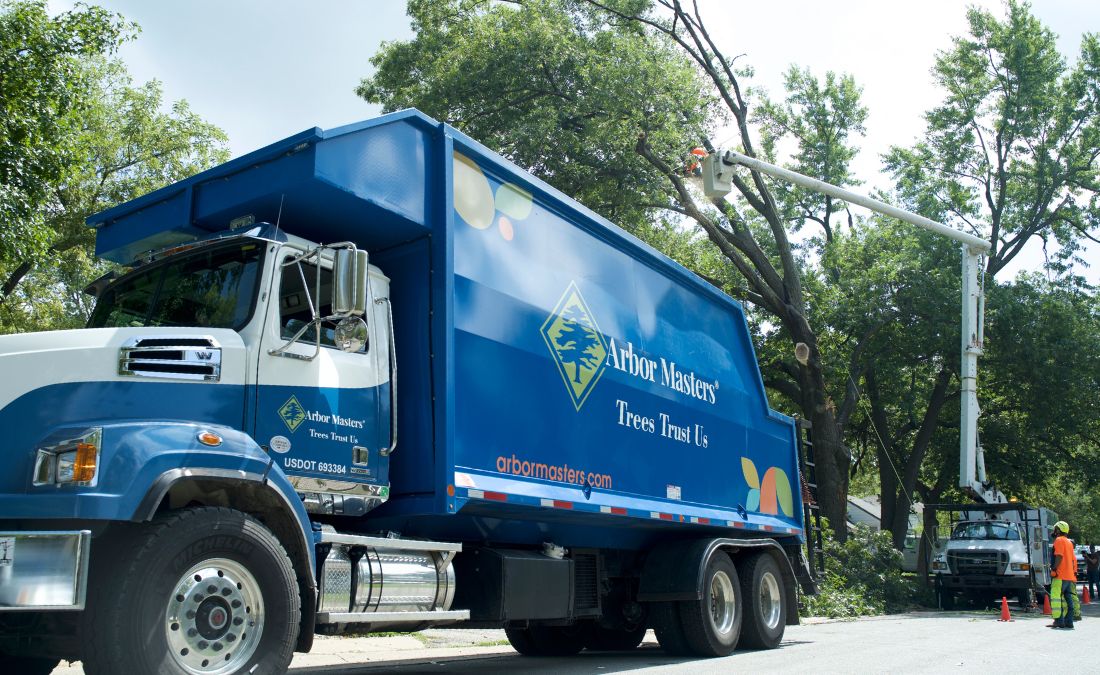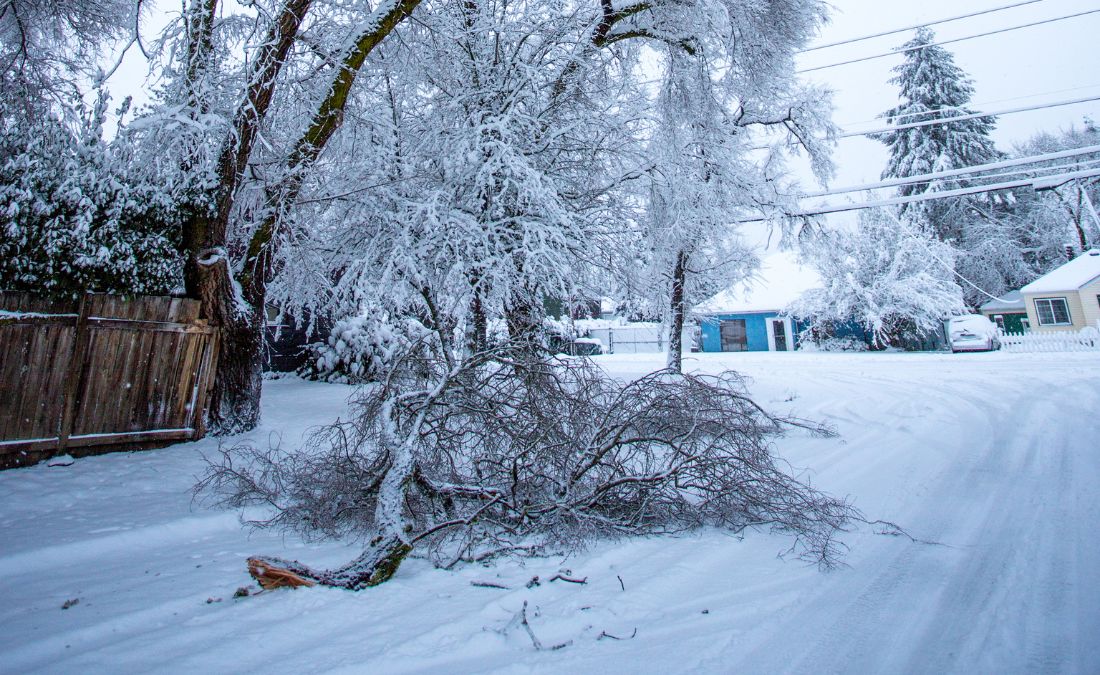5 Warning Signs You Need Emergency Tree Service Before Lee’s Summit Winter Storms
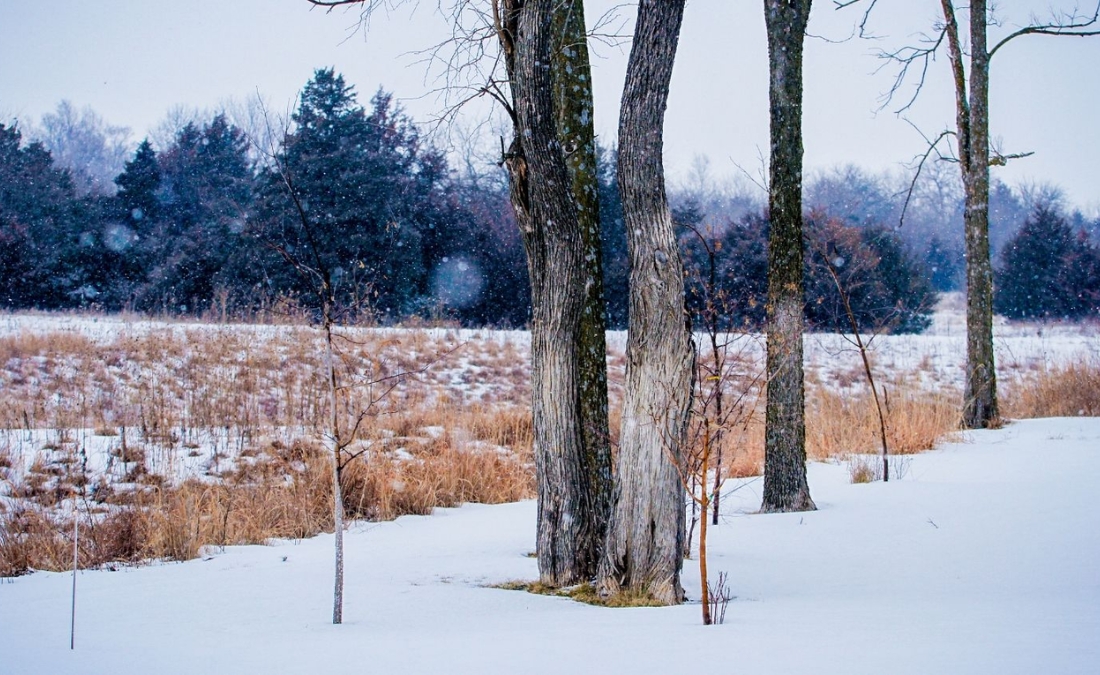
Can you spot a dangerous tree from your driveway? Discover 5 critical signs you need emergency tree service in Lee's Summit before winter storms arrive.
Last winter’s blizzard dumped 11 inches of snow on Lee’s Summit; the fourth-largest single-day snowfall in our history. With recurring winter storm patterns bringing ice and freeze-thaw cycles every six weeks, your trees face mounting stress that turns minor defects into catastrophic failures. And many homeowners don’t even realize their tree is a hazard until it’s crashing through their roof during an ice storm.
Fortunately, there are five critical warning signs you can identify before winter even arrives. Knowing when to call for emergency tree service in Lee’s Summit means you protect your property, avoid expensive emergency rates during storms, and keep your family safe.
Key Takeaways
- Structural failures, like cracks, weak branch unions, or sudden leaning, can signal collapse when ice amplifies existing defects.
- Soil heaving, exposed roots, or fungal growth indicate root compromise as Missouri’s freeze-thaw cycles loosen trees and increase toppling risk.
- Visible decay, like shelf fungus, soft wood, or cavities, signals advanced rot that weakens the outer shell and makes trees unstable under ice.
- Unaddressed storm damage, like hanging branches and torn bark, worsen each winter, becoming fatal failures under ice during recurring storm cycles.
- Even healthy trees near power lines or structures become hazardous as ice-laden branches sag several feet, illustrating the importance of scheduling pre-winter inspections since storm delays can stall emergency service.
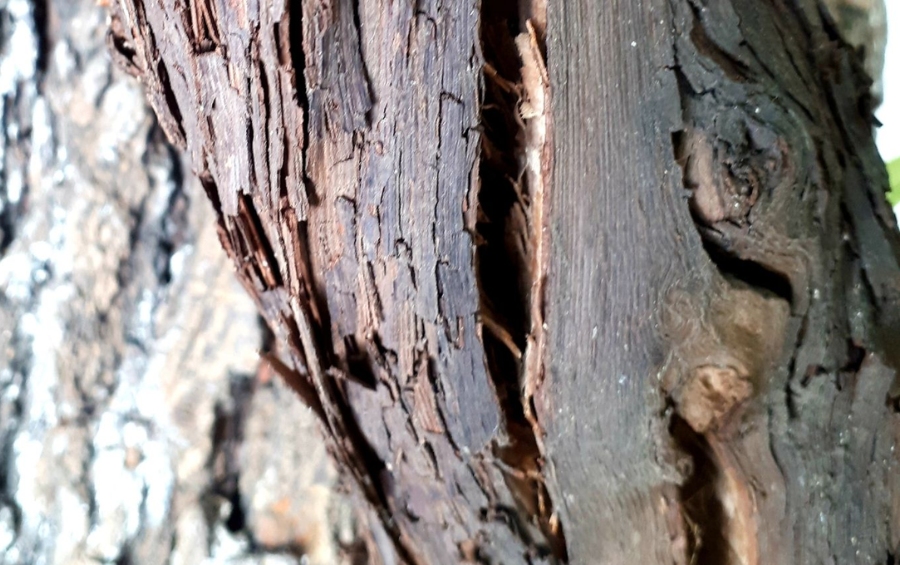
Cracks or bark separation indicate advanced decay; one of the top warning signs that emergency tree service is needed before storms.
Sign #1: Structural Failures Like Cracks, Splits and Dangerous Leans
Structural defects are among the most dangerous tree problems because they lead to sudden, catastrophic failure rather than gradual decline. Walk around your property and look for these critical warning signs:
- Visible cracks where bark separates and exposes interior wood
- V-Shaped branch unions
- Sudden leaning with soil mounding or cracks at the base
- Presence of cankers (dead bark) extending halfway across the trunk
Why Structural Tree Failures Require Immediate Action
The weight of ice accumulation transforms summer-tolerant defects into winter catastrophes. Defects that might have withstood normal wind loads suddenly face weight they were never designed to handle. And cold temperatures make wood brittle, allowing existing cracks to propagate faster.
The problem intensifies with trees that have co-dominant leaders and narrow V-angles; these trees never developed proper bark integration, meaning the trapped bark creates a literal plane of weakness. When wind pressure combines with ice accumulation, it applies double stress to already-compromised unions. And these failures don’t shed branches gradually – entire sections split away catastrophically. If you see visible cracks near weak unions, call for an ISA Certified Arborist assessment as soon as possible.
Sign #2: Root Problems You Can See Above Ground
While roots anchor your tree underground, several above-ground symptoms reveal when your tree’s foundation is compromised. Root problems show few symptoms until catastrophic failure. Walk your tree’s base looking for:
- Raised, cracked, or mounded soil around the trunk
- Exposed roots
- Soft or dark above-ground roots that signal water saturation or death
- Recent lean increase with visible root plate movement
In mature neighborhoods, like Longview Farm, construction damage from trenching or compaction commonly causes these problems.
Why Root Problems Lead to Complete Tree Failure Over Time
Missouri’s freeze-thaw cycles progressively loosen root grip as soil expands when frozen and contracts when it thaws. This constant movement means frozen ground loses its ability to anchor properly during the season when stability matters most. The situation becomes even more critical when late fall rain saturation is followed by hard freezes, creating prime blowdown conditions.
Once ice storms arrive, compromised roots face their greatest test. Ice loading on weakened root systems creates extreme toppling risk, while leafless trees catch winter winds like sails, putting maximum stress on already-damaged anchors. If you notice your tree is leaning with cracks in the soil, call for an immediate tree removal assessment – these trees can topple with little warning during winter storms.
Sign #3: Symptoms of Disease Like Visible Decay or Fungal Growth
Internal decay weakens your tree from the inside out, and by the time you see external symptoms, the damage is often severe. Keep an eye out for the following:
- Conks and mushrooms on the trunk that indicate advanced internal decay
- Soft, crumbly, “punky” wood
- Cavities with rolled edges
- Missing bark patches that won’t regenerate, indicating dead cambium
- Cankers with soft wood
- Excessive woodpecker holes
- Sap weeping
How Decay Compromises Tree Structural Integrity
A tree’s strength works like a hollow pipe: most structural support comes from the outer shell of living wood, not the center. When decay hollows out more than 70% of the trunk’s interior, the remaining wood can’t support winter ice loads.
And while cold weather makes wood brittle, if the wood is also rotten, it becomes even more fragile. Cavities fill with ice and snow, adding weight to weakened structures and increasing the risk of failure when decay combines with other defects. If you see visible decay, such as conks, soft wood, or cavities, schedule an assessment as soon as possible.
Sign #4: Storm Damage That Hasn’t Been Properly Addressed
Trees that survived previous storms may still carry damage that becomes critical when winter ice arrives. Look for these signs of previous storm damage:
- · Hanging branches (“widow makers”)
- · Dead wood throughout canopy
- · Jagged wounds
- · Torn bark and split branches
- · Old wound sites that were never sealed
- · Lightning damage
Why Previous Storm Damage Creates Future Emergencies
Existing storm damage becomes progressively more dangerous as winter progresses. Small limbs can hold hundreds of pounds when coated with ice, transforming widow makers that barely held through summer into critical failures once ice weight is added. Meanwhile, old wounds allow ice and moisture penetration, while freeze-thaw cycles accelerate decay.
The recurring nature of Lee’s Summit’s weather pattern makes this especially concerning. Six-week storm cycles mean multiple opportunities for compound failure, and storm-damaged trees become increasingly vulnerable to secondary pest and disease problems with each event. Hanging or broken branches especially require immediate attention – after all, the term “widow makers” exists because these limbs pose such deadly safety risks.
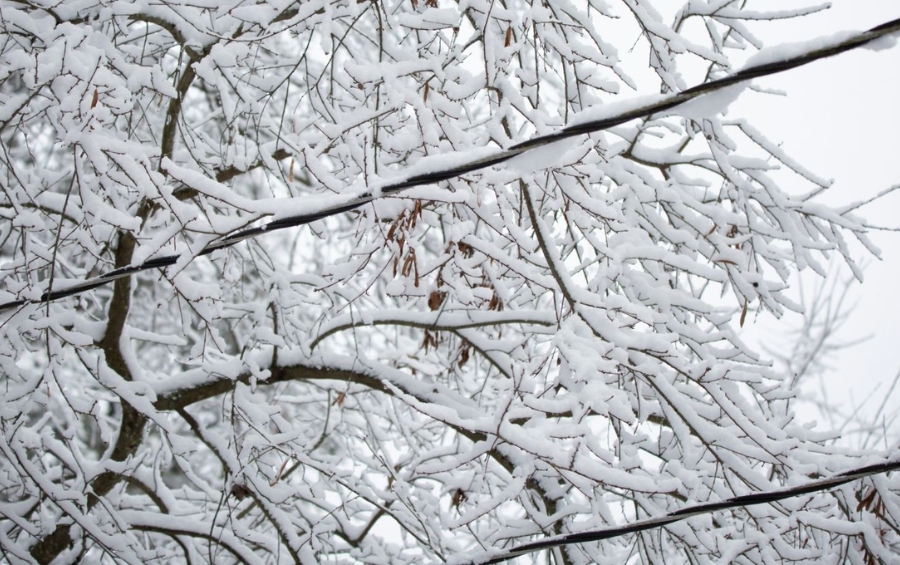
Heavy snow accumulation on tree branches can cause dangerous contact with power lines, creating a serious safety hazard during Lee’s Summit winter storms.
Sign #5: Trees Near Structures or Power Lines
Even healthy trees become hazardous when positioned where failure would cause significant property damage or endanger lives. This includes:
- Large branches above roofs or structures
- Trees touching or within 10 feet of utility lines
- Heavy branches over driveways or walkways
- Property line trees that lean toward neighbors
- Close property spacing
How Proximity Multiplies Emergency Tree Risk
Ice-loaded branches sag 3-5 feet lower than normal, bringing them dangerously close to structures and power lines. The consequences escalate quickly when branches fall on these utility lines, as the lines often snap, creating both electrocution and fire hazards. Even without complete branch failure, falling ice chunks can damage roofs and vehicles below.
The ripple effects extend beyond individual properties. Power outages from trees on lines can leave neighborhoods without electricity for extended periods, as utility crews must wait for professional tree removal before safely restoring power. And since fallen branches also block emergency access when help is needed most, it’s crucial to schedule risk assessments for any tree near a power line or over a structure before winter arrives.
Why Winter Weather Makes Tree Emergencies More Dangerous
Understanding the specific threats winter conditions pose helps explain why seemingly stable trees fail catastrophically during ice storms.
How Ice, Cold, and Wind Damage Trees in Winter
Ice accumulation creates extraordinary weight; just half an inch can add hundreds of pounds to a single branch. Even moderate ice storms deposit enough weight to snap branches that easily handled summer winds and fall leaves.
But weight isn’t the only threat ice poses. Missouri’s freeze-thaw cycles create particularly damaging conditions. Water penetrates cracks and wounds, then expands when frozen, forcing defects to grow larger with each cycle. This repeated stress creates cumulative structural damage that progressively weakens trees throughout the season.
Location is an important factor as well. Properties at Lake Lotawana and Lake Winnebago face amplified risks from wind exposure across open water, where gusts accelerate without obstruction. The bottom line? The combination of ice weight, brittle cold wood, and increased wind pressure transforms summer-tolerant defects into catastrophic failures.
Lee’s Summit’s Winter Storm Pattern and Timing
Lee’s Summit experiences six-week recurring storm cycles, meaning our community faces multiple winter events throughout the January-February ice storm peak. This pattern changes everything – you’re preparing for cumulative damage, not a single event. So, trees that survive one storm may fail during the second or third as weakened structures face repeated stress.
This makes timing critical. Pre-winter assessment is essential; waiting for storm forecasts may be too late for safe removal. Once ice begins falling, even emergency services must delay work until conditions improve.
Frequently Asked Questions About Emergency Tree Service in Lee’s Summit
What’s the difference between emergency tree service and regular tree removal?
Emergency tree service involves immediate response to dangerous situations where trees pose active threats to people, property, or utilities and often require 24/7 availability and rapid mobilization. Regular tree removal is scheduled work on problematic trees that aren’t immediately dangerous, allowing for planning during optimal weather conditions at significantly lower costs than emergency services.
How long does a tree assessment take?
A professional emergency tree assessment by an ISA Certified Arborist typically takes 30-60 minutes depending on property size and number of trees evaluated. You’ll receive an immediate verbal assessment of urgent concerns plus a written evaluation with recommended actions and timeline. For Lee’s Summit homeowners scheduling pre-winter assessments, same-day or next-day appointments are usually available when storms aren’t actively occurring.
Can I remove a hazardous tree myself?
DIY tree removal is extremely dangerous and should never be attempted on large trees, trees near structures or power lines, or trees with structural defects. Tree removal consistently ranks among the most dangerous homeowner activities, with risks including electrocution from power lines, crushing injuries from falling limbs, and property damage from uncontrolled falls. Professional tree services have specialized equipment, training, insurance, and safety protocols that protect you and your property.
Do tree service companies work during winter storms?
Professional tree services operate during winter storms but prioritize emergencies by severity; life-safety hazards, like trees on houses or blocking emergency access, receive immediate response.
However, during active ice storms with ongoing precipitation, even emergency work may be delayed because icy conditions make tree work extremely dangerous for crews. This is why pre-winter assessment and removal of hazardous trees is critical – once the storm hits, you may have to wait for help.
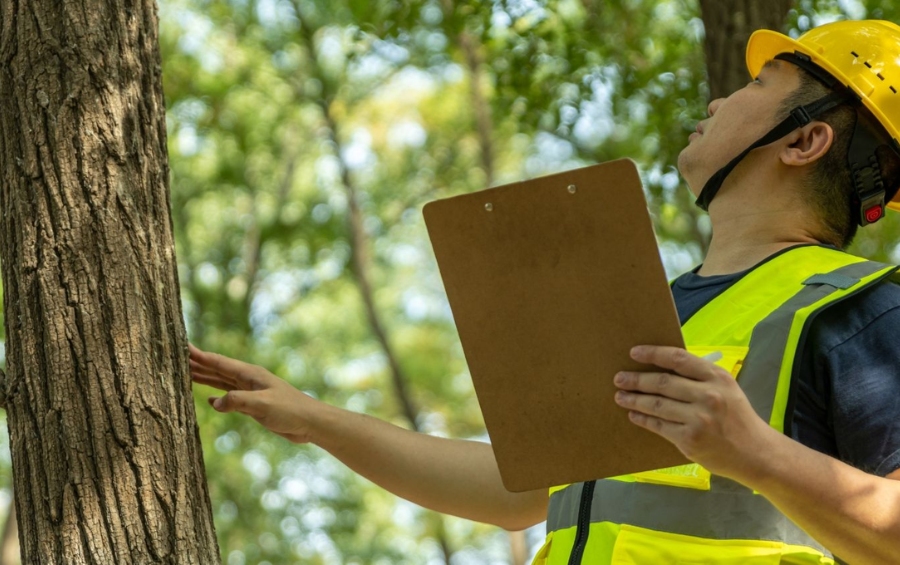
Protect Your Lee’s Summit Property Before the Next Winter Storm with Arbor Masters
Lee’s Summit’s winter storm cycles create multiple failure opportunities each season. But, fortunately, these five warning signs are all visible from the ground right now. You don’t need specialized equipment or training to spot them from your driveway and take action before winter storms hit.
Contact Arbor Masters of Lee’s Summit for a free pre-winter tree risk assessment. Our ISA Certified Arborists serve Lee’s Summit, Lake Lotawana, Lake Winnebago, Lake Tapawingo, Blue Springs, and surrounding areas. Call 816-524-3131 or schedule online before winter storms arrive.

Get the latest local news, tree care tips, special offers, and company updates directly to your inbox! It's easy to subscribe and there's no spam - we promise.
"*" indicates required fields

